Packaged food company Simply Good Foods (NASDAQ:SMPL) missed analysts' expectations in Q1 CY2024, with revenue up 5.3% year on year to $312.2 million. It made a non-GAAP profit of $0.40 per share, improving from its profit of $0.32 per share in the same quarter last year.
Simply Good Foods (SMPL) Q1 CY2024 Highlights:
- Revenue: $312.2 million vs analyst estimates of $316.2 million (1.3% miss)
- Adjusted EBITDA: $57.8 million vs analyst estimates of $56.2 million (2.8% beat)
- EPS (non-GAAP): $0.40 vs analyst estimates of $0.38 (5.7% beat)
- Full year 2024 revenue guidance slightly lowered: now expects growth ~5% vs previous expectation of ~6%
- Gross Margin (GAAP): 37.4%, up from 34.6% in the same quarter last year
- Free Cash Flow of $46.13 million, similar to the previous quarter
- Market Capitalization: $3.25 billion
Best known for its Atkins brand that was inspired by the popular diet of the same name, Simply Good Foods (NASDAQ:SMPL) is a packaged food company whose offerings help customers achieve their healthy eating or weight loss goals.
The Atkins brand, which spans bars, shakes, and frozen meals, emphasizes low-carb and low-sugar foods for weight loss and weight management. The company’s other major brand is Quest, which it acquired for roughly $1 billion in 2019 to broaden its addressable market. Quest offers high-protein cookies, chips, and bars to help consumers maintain a healthy diet or build muscle.
The Simply Good Foods core customer is a health-conscious individual who prioritizes nutritious eating or someone who wants to become that health-conscious person. This individual, however, doesn’t want to completely sacrifice good-tasting foods and treats.
Simply Good Foods' products are available in general retailers such as grocery stores and club warehouse stores as well as in specialty retailers. Consumers have the option to buy single bars or cookies or boxes of them for more regular consumption. The company also has a direct-to-consumer e-commerce site where consumers can buy any Atkins or Quest product.
Shelf-Stable Food
As America industrialized and moved away from an agricultural economy, people faced more demands on their time. Packaged foods emerged as a solution offering convenience to the evolving American family, whether it be canned goods or snacks. Today, Americans seek brands that are high in quality, reliable, and reasonably priced. Furthermore, there's a growing emphasis on health-conscious and sustainable food options. Packaged food stocks are considered resilient investments. People always need to eat, so these companies can enjoy consistent demand as long as they stay on top of changing consumer preferences. The industry spans from multinational corporations to smaller specialized firms and is subject to food safety and labeling regulations.
Competitors include established consumer staples companies that are increasing their healthy food and snack offerings such as Kellogg (NYSE:K) and General Mills (NYSE:GIS) as well as companies solely focused on wellness and nutrition such as Bellring Brands (NYSE:BRBR) and Herbalife (NYSE:HLF).Sales Growth
Simply Good Foods is a small consumer staples company, which sometimes brings disadvantages compared to larger competitors benefitting from better brand awareness and economies of scale.
As you can see below, the company's annualized revenue growth rate of 12.1% over the last three years was solid for a consumer staples business.
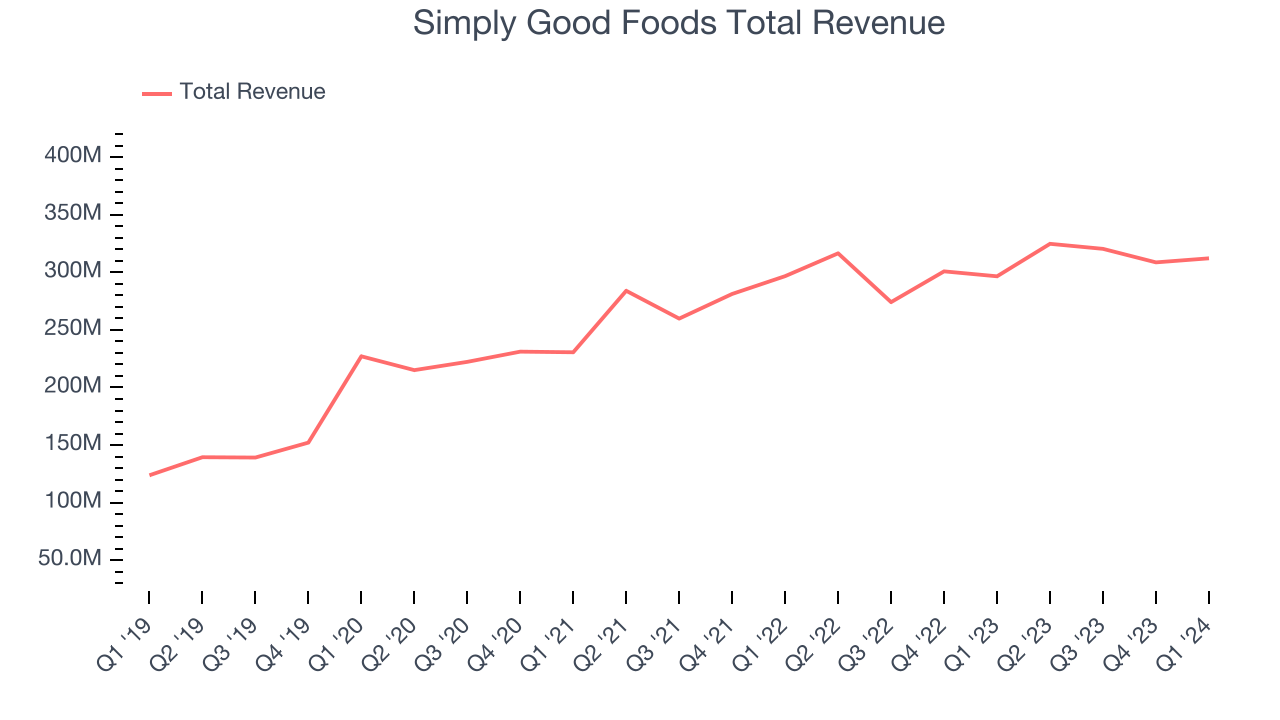
This quarter, Simply Good Foods's revenue grew 5.3% year on year to $312.2 million, missing Wall Street's estimates. Looking ahead, Wall Street expects sales to grow 6.6% over the next 12 months, an acceleration from this quarter.
Gross Margin & Pricing Power
All else equal, we prefer higher gross margins. They usually indicate that a company sells more differentiated products and commands stronger pricing power.
Simply Good Foods's gross profit margin came in at 37.4% this quarter, up 2.8 percentage points year on year. That means for every $1 in revenue, $0.63 went towards paying for raw materials, production of goods, and distribution expenses.
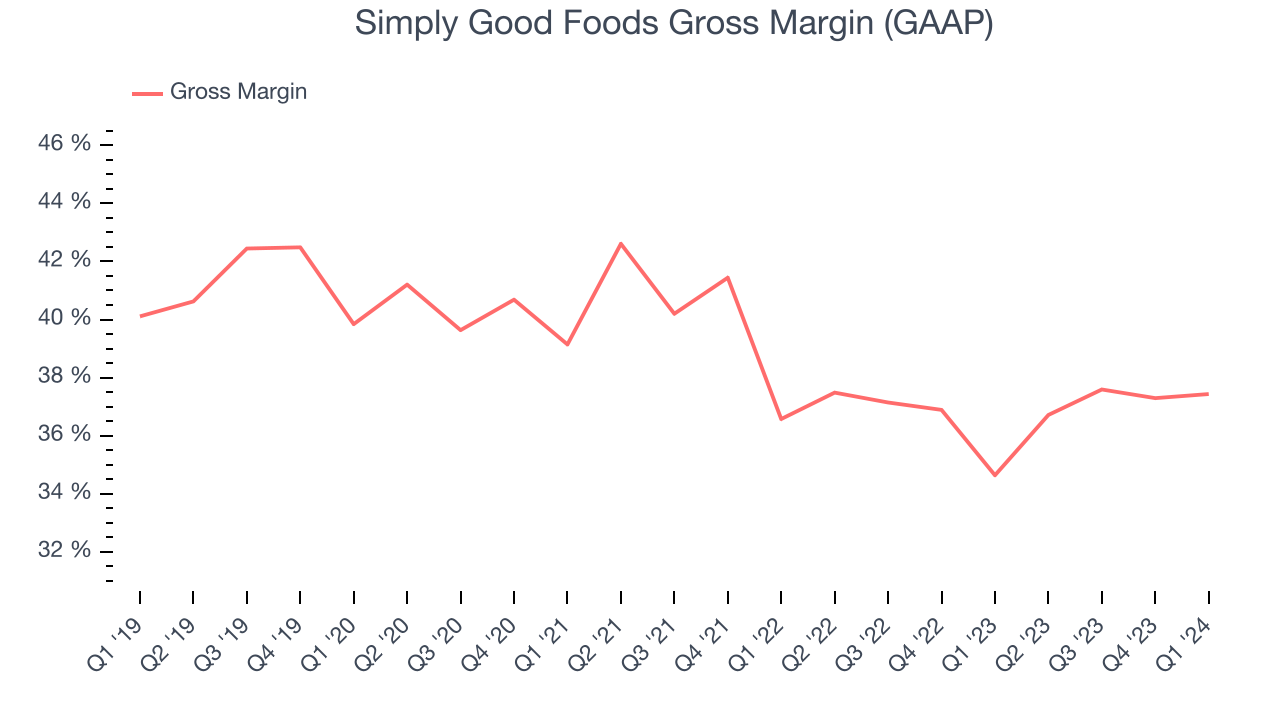
Simply Good Foods's unit economics are higher than the typical consumer staples company, giving it the flexibility to invest in areas such as marketing and talent to reach more consumers. As you can see above, it's averaged a decent 36.9% gross margin over the last eight quarters. Its margin has also been trending up over the last 12 months, averaging 2.1% year-on-year increases each quarter. If this trend continues, it could suggest a less competitive environment where the company has better pricing power and more favorable input costs (such as raw materials).
Operating Margin
Operating margin is a key profitability metric for companies because it accounts for all expenses enabling a business to operate smoothly, including marketing and advertising, IT systems, wages, and other administrative costs.
This quarter, Simply Good Foods generated an operating profit margin of 15.4%, up 1.1 percentage points year on year. This increase was solid and driven by stronger pricing power and lower raw materials/transportation costs, as indicated by the company's larger rise in gross margin.
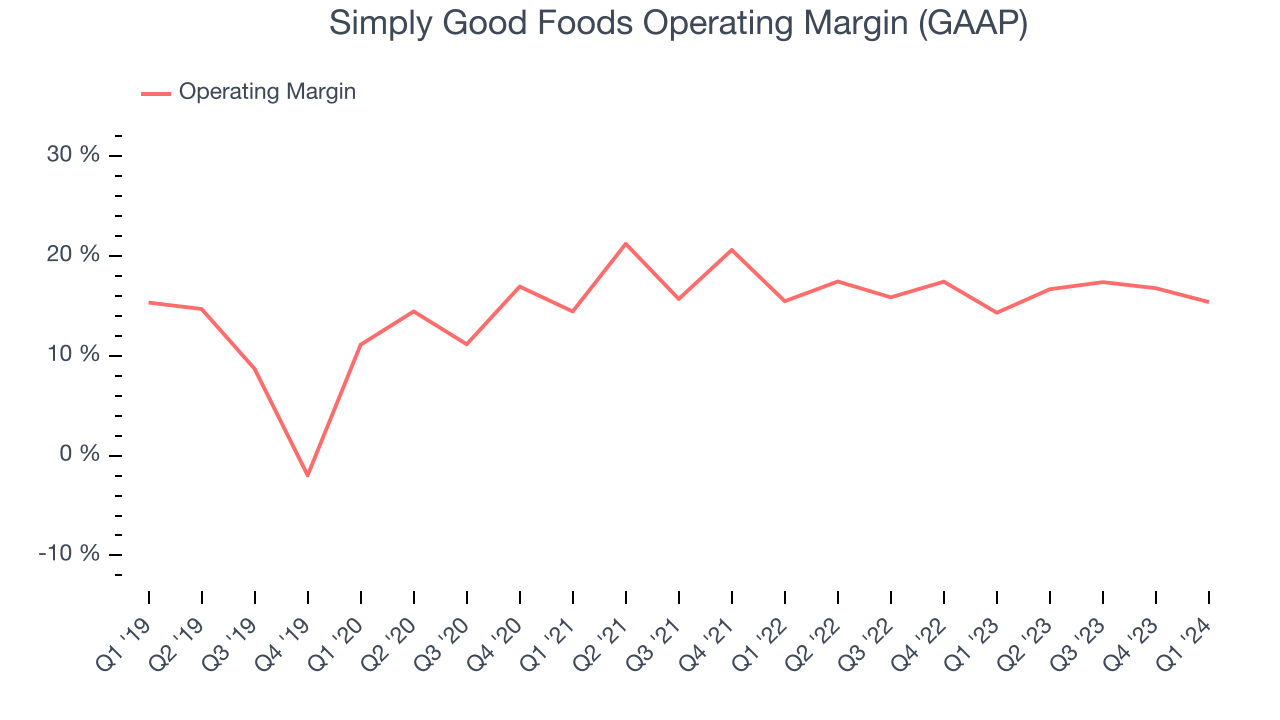 Zooming out, Simply Good Foods has been a well-managed company over the last eight quarters. It's demonstrated it can be one of the more profitable businesses in the consumer staples sector, boasting an average operating margin of 16.4%. On top of that, its margin has remained more or less the same, highlighting the consistency of its business.
Zooming out, Simply Good Foods has been a well-managed company over the last eight quarters. It's demonstrated it can be one of the more profitable businesses in the consumer staples sector, boasting an average operating margin of 16.4%. On top of that, its margin has remained more or less the same, highlighting the consistency of its business. EPS
These days, some companies issue new shares like there's no tomorrow. That's why we like to track earnings per share (EPS) because it accounts for shareholder dilution and share buybacks.
In Q1, Simply Good Foods reported EPS at $0.40, up from $0.32 in the same quarter a year ago. This print beat Wall Street's estimates by 5.7%.
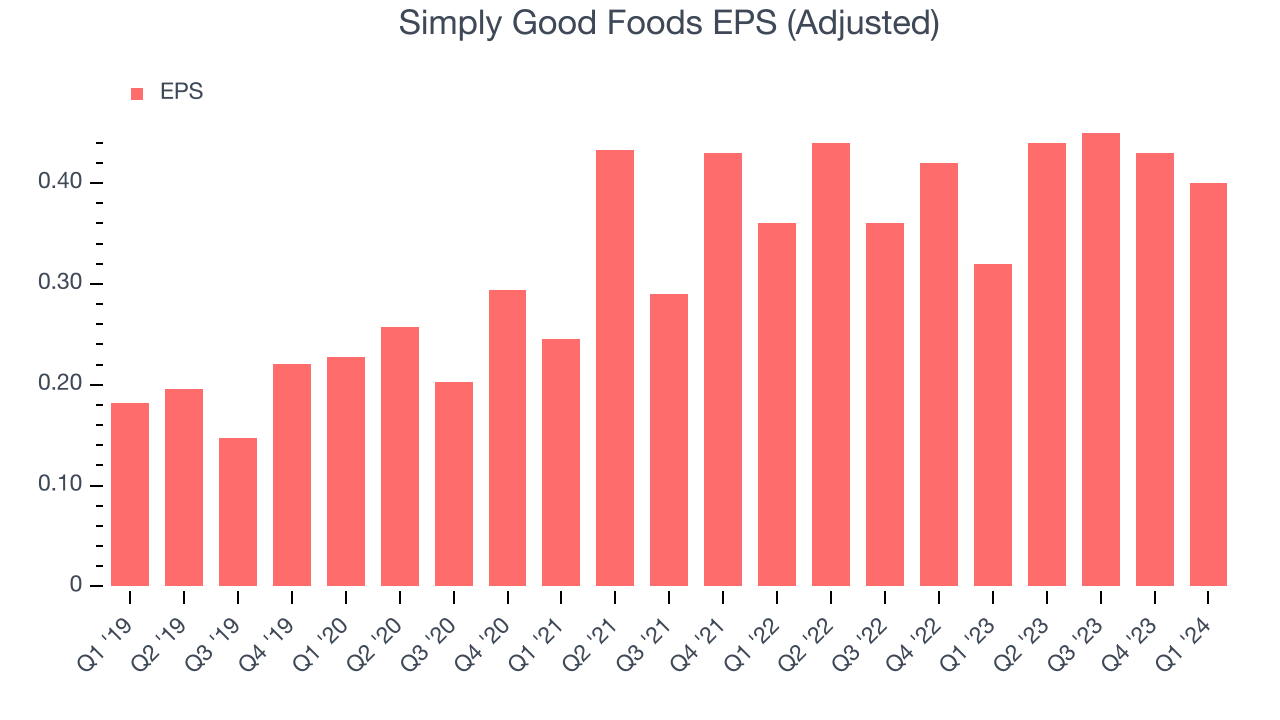
Between FY2021 and FY2024, Simply Good Foods's EPS grew 72.1%, translating into a remarkable 19.8% compounded annual growth rate. This growth is materially higher than its revenue growth over the same period, showing that Simply Good Foods has excelled in managing its expenses.
Wall Street expects the company to continue growing earnings over the next 12 months, with analysts projecting an average 10.3% year-on-year increase in EPS.
Cash Is King
If you've followed StockStory for a while, you know we emphasize free cash flow. Why, you ask? We believe that in the end, cash is king, and you can't use accounting profits to pay the bills.
Simply Good Foods's free cash flow came in at $46.13 million in Q1, in line with the same quarter last year. This result represents a 14.8% free cash flow margin.
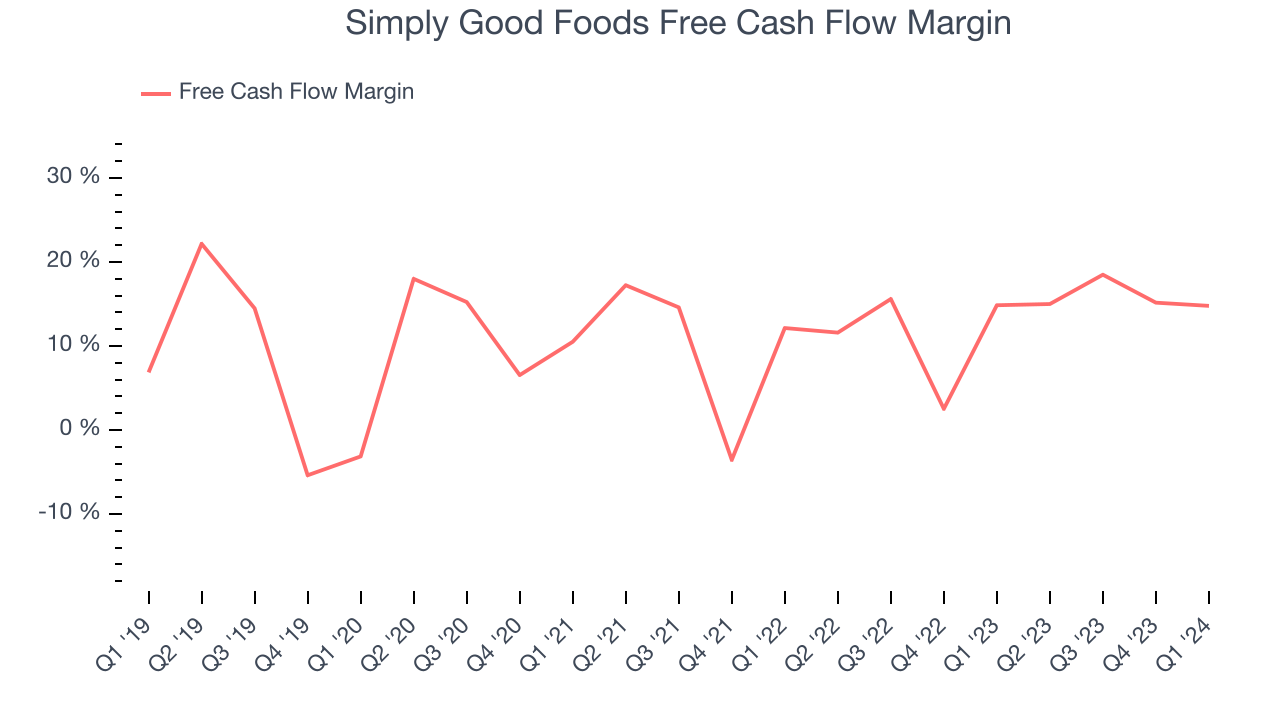
Over the last eight quarters, Simply Good Foods has shown terrific cash profitability, enabling it to reinvest, return capital to investors, and stay ahead of the competition while maintaining a robust cash balance. The company's free cash flow margin has been among the best in the consumer staples sector, averaging 13.5%. Furthermore, its margin has averaged year-on-year increases of 4.8 percentage points over the last 12 months. This likely pleases the company's investors.
Return on Invested Capital (ROIC)
EPS and free cash flow tell us whether a company was profitable while growing revenue. But was it capital-efficient? A company’s ROIC explains this by showing how much operating profit a company makes compared to how much money the business raised (debt and equity).
Simply Good Foods's five-year average ROIC was 7.4%, somewhat low compared to the best consumer staples companies that consistently pump out 20%+. Its returns suggest it historically did a subpar job investing in profitable business initiatives.
The trend in its ROIC, however, is often what surprises the market and drives the stock price. Over the last five years, Simply Good Foods's ROIC averaged 4.3 percentage point increases each year. This is a good sign, and if the company's returns keep rising, there's a chance it could evolve into an investable business.
Key Takeaways from Simply Good Foods's Q1 Results
It was good to see Simply Good Foods beat analysts' gross margin, adjusted EBITDA, and EPS expectations this quarter. On the other hand, its revenue unfortunately missed analysts' expectations and its operating margin missed Wall Street's estimates, and the company slightly lowered full year revenue guidance. Overall, the results were mixed, but they seem to be better than feared. The stock is up 3.1% after reporting and currently trades at $33.57 per share.
Is Now The Time?
When considering an investment in Simply Good Foods, investors should take into account its valuation and business qualities as well as what's happened in the latest quarter.
We have other favorites, but we understand the arguments that Simply Good Foods isn't a bad business. First off, its revenue growth has been solid over the last three years. And while its brand caters to a niche market, its powerful free cash flow generation enables it to stay ahead of the competition through consistent reinvestment of profits.
Simply Good Foods's price-to-earnings ratio based on the next 12 months is 17.2x. In the end, beauty is in the eye of the beholder. While Simply Good Foods wouldn't be our first pick, if you like the business, the shares are trading at a pretty interesting price right now.
Wall Street analysts covering the company had a one-year price target of $43 per share right before these results (compared to the current share price of $33.57).
To get the best start with StockStory, check out our most recent stock picks, and then sign up to our earnings alerts by adding companies to your watchlist here. We typically have the quarterly earnings results analyzed within seconds of the data being released, and especially for companies reporting pre-market, this often gives investors the chance to react to the results before the market has fully absorbed the information.
